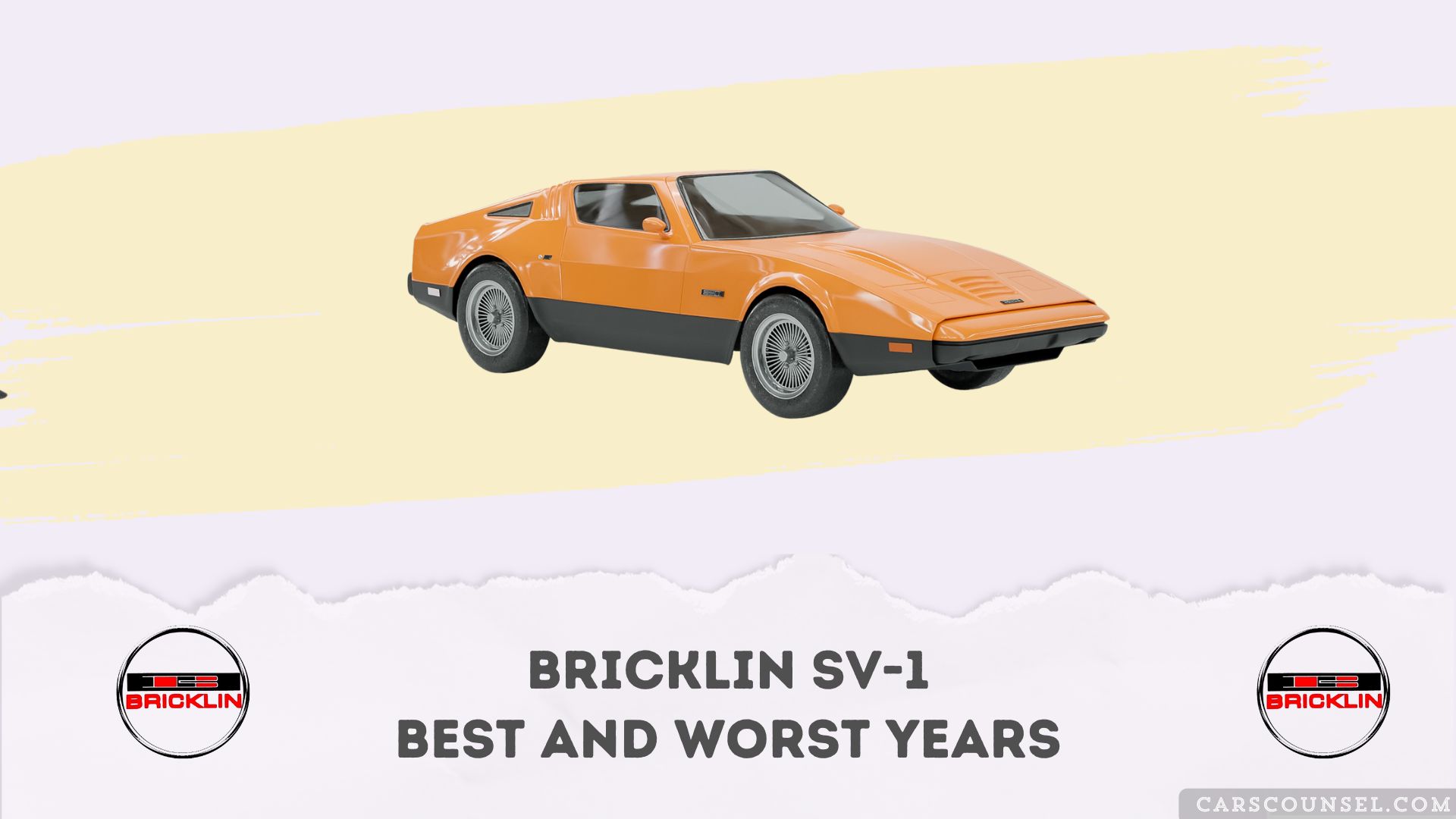As you take a step back to appreciate the Bricklin SV-1’s, shall we say, distinctive design, you can’t help but wonder what went right — and wrong — during its production run.
With its brightly colored, dent-resistant plastic body and hand-removable gullwing doors, this car was clearly a pioneer of its time, especially during what many consider its best years between 1974 and 1975.
But, as you’re about to find out, its innovative features were only half the story. The rest is a tale of technical woes, design flaws, and some rather… curious… decisions that would ultimately seal its fate.

Quick Navigation
Key Takeaways
- The worst years for the Bricklin SV-1 were 1974-1976, marked by production issues, quality problems, and a hefty price tag.
- The 1975 Bricklin SV-1 suffered from design flaws, electrical issues, and a poor performance, making it one of the worst sports cars of its time.
- The Bricklin SV-1’s best feature was its novel safety features, including brightly colored, dent-resistant plastic bodies, and hand-removing.
- Despite its poor performance, the SV-1’s unique design, gullwing doors, and fiberglass body made it a standout in the sports car market.
- The Bricklin SV-1’s poor sales and financial struggles led to its discontinuation in 1976 being its final production year.
The Birth of Bricklin’s Brand and SV-1 Development
As the 1960s drew to a close, Malcolm Bricklin, the founder of Subaru of America, faced a major setback when Consumer Reports branded the 360 microcar “not acceptable” in 1969 due to safety concerns.
You might think this would have discouraged Bricklin, but it only fueled his passion to create a car that prioritized protection.
In 1972, he brought the Safety Vehicle 1 (SV-1) prototype to life, aiming to build a car that looked good, was fun to drive, and prioritized safety.
Bricklin’s experience with Subaru influenced the SV-1’s design, making it one of the safest sports cars of 1974.
Design and Technical Issues
As you examine the Bricklin SV-1’s design and technical issues, you’ll notice the car’s body was made from a plastic-fiberglass composite, which came with its own set of problems.
The iconic gullwing doors were a standout feature, but they weighed nearly 100 lbs and could fail suddenly, causing more problems than they were worth.
Additionally, the car’s weight and performance were compromised by its 3,500-lb frame and underwhelming engine options.
Body Material Issues
One of the most critical design and technical issues plaguing the Bricklin SV-1 is its body material.
You’ll experience a range of problems due to the plastic-fiberglass composite used in the SV-1’s construction.
This material leads to:
- Frequent overheating issues that can cause electrical problems and leaks
- Gullwing doors that can trap you inside or destroy the motor
- Resin panels and bumpers that add weight, affecting acceleration and top speed
- Pop-up headlights that can fail to pop up, reducing visibility
- A poor performance and safety record due to the body material issues
Gullwing Door Problems
You’re likely aware that the SV-1’s body material issues have far-reaching consequences, and one of the most problematic aspects is its gullwing doors.
These iconic doors weighed nearly 100 lbs and could fail suddenly, trapping occupants inside or destroying the motor completely.
The pneumatic rams that assisted the doors often failed, making it difficult to enter or exit the vehicle.
The hydraulic system was prone to issues, causing the doors to fail to open or close properly.
As a result, the Bricklin SV-1’s unique feature became a major design flaw, leading to numerous problems and complaints from owners.
Weight and Performance
The Bricklin SV-1’s weight, a staggering 3,850 pounds, severely impacted its performance, making it one of the slowest cars of its time, with a 0-60 mph time of 8.5 seconds.
You can’t help but feel frustrated with the car’s underwhelming acceleration and handling.
The car’s weight was largely due to the resin panels and bumpers, which added significant heft to the already-heavy gullwing doors.
The SV-1’s Ford 351 cu-in V8 engine, producing only 175 hp, was underpowered for the car’s weight, leading to poor acceleration and handling.
The three-speed automatic transmission further hindered the car’s performance, making it feel sluggish and unresponsive.
The lack of a roll cage made the car’s poor weight distribution even more concerning.
The SV-1’s weight issues made it a car that was more about show than go.
Interior and Quality Control
As you step inside the SV-1, you’ll notice the interior’s basic design, lacking headroom and poor ergonomics around the pedals and gauges.
The materials used are also underwhelming, with glued-on dashboard trim and poorly fitting vinyl and carpeting.
You’ll also be bothered by the significant wind noise that seeps into the cabin.
Interior Flaws
How does a car touted as a premium vehicle end up with an interior that’s a masterclass in poor design and cheap materials?
You’d expect the SV-1’s interior to be a haven of comfort and sophistication, but it’s anything but.
Instead, you’re greeted with:
- A lack of headroom and poor ergonomics around the pedals and view angle of the gauges
- Terrible visibility thanks to thick A-pillars, angled hatch, and high window-line
- Carpeting that fits poorly and low-quality AMC economy-oriented parts like the shifter gate
- A high amount of wind noise that further contributes to the overall poor interior experience
- An interior design that’s stereotypically 1970s, but lacks the quality and refinement expected from a car in its price range
Basic Materials Used
You step into the SV-1, expecting premium quality, but what you get is an interior trimmed with vinyl – a rather basic material for the price the car commanded when new.
The carpeting fits poorly, adding to the overall poor quality control of the vehicle.
The interior material is glued onto the dashboard, giving it a cheap feel.
The Bricklin SV-1’s interior has a stereotypical 1970s appearance, but the quality is subpar.
The use of vinyl and poor carpeting makes the interior feel low-rent, a disappointment considering the SV-1’s original price tag.
Wind Noise Issues
The Bricklin SV-1’s design and build quality issues led to an unacceptable level of wind noise in the interior.
You’ll notice the thick A-pillars, angled hatch, and high window-line obstruct your view and create a loud, uncomfortable ride.
- The interior material is basic and glued onto the dashboard, adding to the wind noise problem.
- The poor fit of the carpeting contributes to the issue.
- You’ll struggle with poor visibility, making it difficult to navigate.
- The wind noise is just one of many quality control problems you’ll face.
- You’ll feel frustrated with the lack of attention to detail in the SV-1’s design.
Pricing, Production, and Legacy
Originally pitched as an affordable ride, the Bricklin SV-1’s sticker shock was undeniable: by 1975, its price had ballooned to $9,800, equivalent to a whopping $53,000 today.
You might’ve thought it was a steal, but the comparably plastic-bodied, V8-powered Corvette of 1975 was nearly $2,000 less, making it a more attractive option for buyers.
| Year | Units Produced | Units Produced |
|---|---|---|
| Feature | Description | |
| Body | Fiberglass, safe, and stylish | |
| Doors | Gullwing, hand-removing, 100-lb | |
| Interior | Air conditioning, AM/FM radio, luxurious amenities | |
| Safety | Power brakes, power steering, ahead of its time |
Malcolm Bricklin’s Later Ventures
After transforming the automotive industry with the Bricklin SV-1, Malcolm Bricklin ventured into new territories.
He introduced the Yugo to America in 1985, selling over 160,000 units in its first year.
Bricklin sold his interest in the Yugo for $20 million in 1988, just before UN sanctions ended its American run.
Today, his company, Visionary Vehicles, develops the Bricklin 3EV, a plug-in hybrid car.
- You might wonder how Bricklin went from a sports car to a budget-friendly Yugo.
- His Yugo venture was marked by controversy and eventual failure.
- Despite setbacks, he continues to pursue his passion for innovative vehicles with the Bricklin 3EV.
- His perseverance is admirable, considering the Bricklin 3EV’s production challenges.
- Will Bricklin’s latest venture finally bring him the success he’s been chasing since the Bricklin SV-1?

